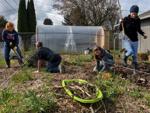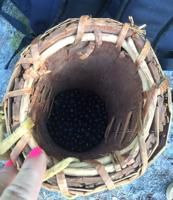
Cowlitz County community gardens address food insecurity, promote healthy eating | Health
Table of Contents
With 20 raised beds taking up her yard, it’s not surprising Barb Vollmert spent Thursday morning gardening.
But the Highlands resident wasn’t at home. She was a five-minute walk from her house, working with her husband and brother among the artichokes, kale and rhubarb at the community garden on 21st Avenue.
Vollmert became manager this year, and said she is focusing on growing “the basics,” like tomatoes, squash and peppers, to produce a high-volume harvest.
Unlike other garden users, Vollmert doesn’t need the space to grow her own food, but works there “to help my neighborhood.”

Last year, Kimberly Griffith delivered 100 pounds of free fruits and vegetables grown in a community garden near Archie Anderson Park to resid…
Vollmert said the Highlands, her home since 2010, gets a bad reputation. Traditionally a low-income area, many residents lack transportation and cooking skills, she said. Vollmert said she’s concerned drought and supply chain issues will affect food availability this year.
“It’s important to have fresh produce within walking distance,” she said.
People are also reading…
The Highlands garden is one of several resources for Cowlitz County residents — with and without yards — to get healthier food compared to typical nearby options at convenient stores or gas stations.
Local nonprofits are using community gardens to make it easier for people with limited incomes or transportation to grab fresh produce and, in turn, spread healthier food habits to their communities, often plagued with chronic diseases and little knowledge of cooking with fresh fruits and vegetables.
Growing interest
Some community gardens are free to use or work in, and others rent plots for residents to grow their own produce. At most of the local gardens, extra produce is shared with those in need.
Over the last four years, interest has picked up at the city of Longview’s community garden on 32nd Avenue, where residents pay a fee to rent one of the 125 plots, said Justin Brown, recreation manager.
The 4-acre garden has been around since at least the early 1980s, and is unique for a city this size, Brown said. Enthusiasm for community gardens has been rising for the last seven to 10 years as smaller lot sizes and multifamily housing becomes more prevalent, he said.
“Space is a big deal, a scarce asset for people, so being able to provide that space for them to garden is a great thing,” he said.
Last year, the city started a new community garden at Victoria Freeman Park. Inflation and supply chain issues paused construction, but the available plots are almost full, Brown said.

A new community garden in Victoria Freeman Park on Ninth Avenue and Douglas Street in Longview will take shape over the next few months in ord…
Unlike the 32nd Avenue garden, the new space gave priority to neighborhood residents, he said. The department, Longview Parks and Recreation Foundation and PeaceHealth St. John Medical Center partnered on the project, designed to improve access to fresh food in the low-income neighborhood.
Food insecurity
Access to resources for food insecure households improved over the past few years, but the need has increased, according to PeaceHealth St John Medical Center’s 2022 Community Health Needs Assessment.
“There is a clear connection between food insecurity and high levels of stress, poor nutrition and chronic diet-related diseases like obesity and diabetes,” the assessment states.
As of 2019, 14.5% of Cowlitz County residents were food insecure, meaning they had limited or uncertain access to adequate food, according to nonprofit Feeding America.
A statewide survey conducted by the University of Washington and Washington State University found food insecurity increased during 2020 and into early 2021. About 12% of Cowlitz County residents reported very low food security and 13% reported low food security, according to the survey.

Rising food and gas prices over the last month and a half have increased demand at Cowlitz County food banks.
Statewide, food insecurity was highest among people of color and those who were unemployed, low-income and without a college-level education, the survey found.
Of Cowlitz County’s food insecure residents, an estimated 26% were above the threshold for SNAP or other benefits requiring participants to be at or below 200% of the federal poverty line, according to Feeding America. SNAP, or the Supplemental Nutrition Assistance Program, provides benefits to eligible families to purchase healthy food.
Cowlitz County’s Washington State University Extension Office runs the SNAP-Ed program, teaching residents skills to lead healthy, active lives and how to make the most of their SNAP benefits, said Elizabeth Stratton, program manager.
Since 2019, SNAP-Ed has partnered with Highlands Neighborhood Association to run the group’s community garden, Stratton said. The garden program focuses on not just giving people produce, but teaching them how to grow their own and providing supplies, she said. Last year, the garden gave out about 600 fruit and vegetable starts and encouraged 65 families to grow their own food, she said.
The program also promotes access to produce elsewhere, including at the Cowlitz County Farmers Market and community produce stands, Stratton said.

Twice a week, Robert Loren lugs several dozen pounds of fresh produce to the parking lot of the Church of Christ in South Kelso, sets up a car…
“It’s really important to have so many different places people can access these things,” she said. “For SNAP-Ed and this program, we’re working hard to make the healthy choice the easy choice.”
‘Food is medicine’
Poverty — and food insecurity — in Cowlitz County varies by location and racial and ethnic group, with the highest rate among American Indians and Alaska Natives at 40%.
In 2019, the Cowlitz Indian Tribe Health and Human Services started its Community Wellness Garden to help address food insecurity among tribal members, said Alyssa Fine, wellness and diabetes program coordinator.
Three full-time staff operate the garden, located at the tribe’s property in Toledo, and distribute produce to tribal members and other clients at eight locations, including Longview, Fine said. Garden staff and volunteers in 2021 harvested just over 7,300 pounds of produce and distributed to 430 individuals. Produce is also used in meals for the Cowlitz Elders Program.
“We were really inspired by the elders who had a small garden on that site,” Fine said. “We worked off of that, recognizing the food insecurity that exists in the Native community.”
Since the beginning, demand has exceeded supply, and the department hopes to continue increasing production and programming to meet the community’s needs, Fine said.
In the last four years, the program has expanded from eight raised beds and one 10,000-square foot garden to include an additional in-ground garden and tunnel to extend the growing season, Fine said. A third similarly-sized garden, greenhouse and Native plant walk are in the works, she said.
The program also provides access to recipes, cooking demonstrations and helps demystify less common vegetables and give people confidence they can use them, Fine said.

Huckleberry picking season has hit its peak in Washington.
Along with addressing food insecurity, the program includes education, promoting tribal food sovereignty and helps get people outside and connecting with the earth, she said.
“We say that food is medicine and that applies in a number of different ways,” Fine said.
Eating a healthy diet full of fresh fruit and vegetables is a key part of managing chronic disease, including diabetes, high blood pressure and heart disease, Fine said. Getting outside and moving around improves people’s physical and mental health, she said. Gardening can also help people access culturally significant food and improve social wellness, Fine said.
“That’s what magic about gardens and community garden spaces, is how many ways it works to impact a community’s well-being, and individual health and wellness,” she said.
While long-term outcomes, including changes to rates of chronic disease, are difficult to measure, Fine said she believes the program is helping people be healthier.
“One of the hardest things as a nurse and diabetes educator was to sit with a patient and say, ‘This is what a healthy meal looks like,’ but realizing they can’t make that happen because of lack of access to resources and ingredients,” Fine said. “To be able to not just say that, but, ‘If you’re having trouble here’s a way to get those items,’ is very powerful. It allows us to fill those gaps and not let those patients walk away without gaining access to what they need to make those changes.”
School gardens
Over the last decade, a similar education has taken root at Longview and Kelso elementary and middle schools, where students often come from lower-income homes with unhealthier eating habits.

Let it be said that the new coronavirus couldn’t thwart these green thumbs.
The Lower Columbia School Gardens program has expanded to 19 schools, and includes gardening and cooking programs. Ian Thompson, operations coordinator and founder, said the nonprofit integrated cooking into its programs early on.
“I think we just saw pretty quickly that, yes, you can eat carrots, berries, peas straight out of the garden, but a lot of food needs to be cooked,” he said. “Really seeing the disconnect in how many kids and families don’t have access or exposure to people preparing meals from scratch … and we started doing it and realized kids really responded to it.”
Staff and volunteers hear stories every day from students and parents about the lessons making a difference at home, Thompson said. Telling children and adults they need to swap processed foods for fresh items won’t “move the needle,” but teaching to grow their own food has, he said.
“This thing is almost miraculous. It changes peoples’ relationships with food,” Thompson said.
